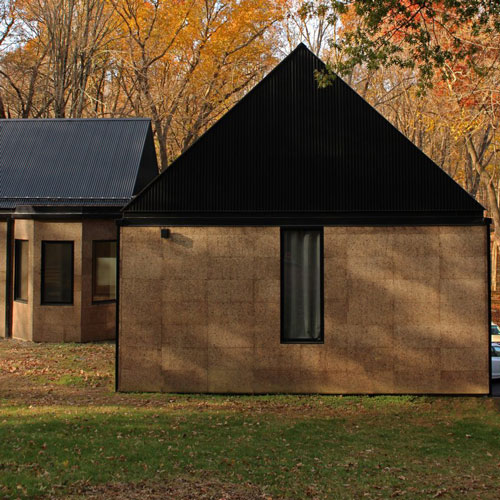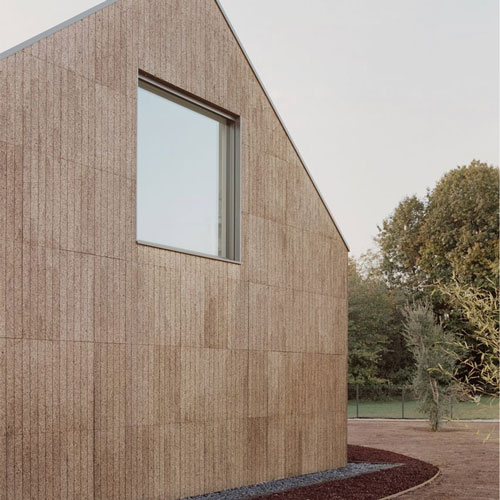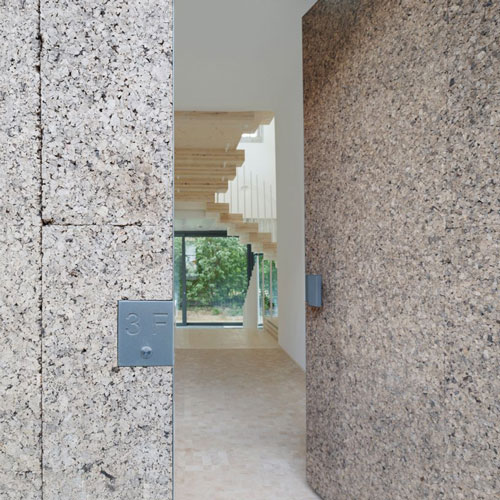
Le liège possède une isolation thermique et acoustique et est capable de réguler la température ambiante. Il offre un confort dans les endroits qui nécessitent des soins particuliers (par exemple les hôpitaux, les écoles, les jardins d'enfants, les théâtres, les cinémas, les bâtiments commerciaux, les salles de conférence, etc.). Le liège est résistant, adoucit les impacts, et sa forte capacité d'absorption acoustique contribue à réduire le bruit, en plus d'être confortable, naturel, écologique, hygiénique et sain, durable et facile à entretenir. Nous répertorions ici les 10 meilleurs modèles de liège en architecture.

Le pavillon portugais de l'Expo de Shanghai a une façade en liège. Le liège est un matériau portugais caractéristique, non seulement respectueux de l'environnement mais également recyclable. Cet exemple créatif et respectueux de l'environnement a été choisi pour promouvoir l'image du Portugal à l'Expo. La place commerciale de Lisbonne, un espace urbain qui fascine les Portugais, sera également à l’honneur. En outre, le pavillon présentera non seulement le concept de durabilité dans la ville moderne, mais soulignera également le rôle important que joue ce concept dans les politiques économiques et environnementales du Portugal.


L'architecte Nate Dalesio a réalisé une maison recouverte de liège à New York pour lui et sa jeune famille.
Selon l’architecte, le liège constitue une couche supplémentaire d’isolation qui contribue à réduire la consommation d’énergie de chauffage de la maison.
Dalesio déclare : « Un budget modeste de 150 $ le pied carré a été utilisé pour investir dans des murs, un toit, des planchers et des fenêtres hautement isolés afin de minimiser les factures de services publics, et le revêtement extérieur a également servi d'isolation en panneaux de liège. »
Le liège est un matériau de construction utile car il résiste naturellement à l’humidité et à la moisissure. Il est également léger et peut être recyclé après utilisation.


LCA Architetti a utilisé du liège, de la paille et du bois pour construire une maison simple et durable surplombant les bois dans la petite ville de Magnago, en Italie.
Bien nommée « Maison du bois, de la paille et du liège », cette maison près de Milan a été commandée par un jeune couple qui souhaitait vivre de manière plus durable et en contact plus étroit avec la nature.


La conception de LCA Architetti a été délibérément réduite pour maintenir l’accent sur le cadre rural de la maison tout en minimisant son impact environnemental.
Cela a été rendu possible grâce à l'utilisation de matériaux de construction naturels et recyclés, notamment des structures préfabriquées en bois, une isolation en paille et un revêtement en liège, un matériau renouvelable, résistant et isolant récolté à partir de l'écorce du chêne-liège.
L’utilisation du liège fournit également une peau thermiquement efficace à la maison qui, associée à l’isolation en paille, contribue à minimiser les besoins énergétiques du bâtiment.
La paille utilisée pour isoler le bâtiment provenait de plants de riz jetés par les agriculteurs locaux.
The Serpentine Gallery in London has unveiled the plans of Swiss architects Herzog & de Meuron and Chinese artist Ai Weiwei for the Serpentine Gallery pavilion: they will carry out an archaeological excavation to find traces of the former pavilion on the site and then cork it over the trench.
L'intérieur du pavillon sera recouvert de liège, un matériau de construction durable choisi pour ses qualités uniques et faisant écho à la terre excavée. En utilisant une approche archéologique, les architectes ont créé un design qui incitera les visiteurs à contempler sous la surface du parc et à voyager dans le temps à travers les fantômes des bâtiments antérieurs.


Le studio d'architecture sud-africain Counterspace utilisera du liège et des briques fabriqués à partir de déchets de construction recyclés pour construire le Serpentine Pavilion de cette année, en s'appuyant sur les expériences des communautés de migrants de Londres dans la conception.
Le module K-Briq est une nouvelle technologie de Kenoteq qui utilise 90 % de déchets de construction et de démolition recyclés pour fabriquer les briques qui seront utilisées dans le pavillon.
Selon Kenoteq, comme ces briques n’ont pas besoin d’être cuites, elles ne produisent qu’un dixième des émissions de carbone des briques cuites standards.
L'autre matériau principal sera le liège du producteur portugais Amorim. Le liège est considéré comme une alternative plus durable à de nombreux bois car il ne nécessite pas d’abattre des arbres pour récolter l’écorce.


Matthew Barnett Howland, Dido Milne et Oliver Wilton ont utilisé des blocs de liège pour construire la Cork House dans le Berkshire, en Angleterre, qui a été sélectionnée pour le prix Stirling de cette année.
Située dans les haies au bord de la Tamise, la maison a été conçue par Howland, Milne et Wilton pour répondre à l'impact du secteur de la construction sur la biodiversité, aux émissions de gaz à effet de serre et au recours à des matériaux jetables.
La maison se compose de cinq volumes, surmontés d'une lucarne pyramidale et constitués de blocs de liège durables soutenus par des éléments en bois. Il est conçu pour être facilement démonté, réutilisé ou recyclé à l'avenir.
La maison se compose de 1 268 blocs de liège combinés en cinq volumes reliés par un toit unique composé de cinq puits de lumière en forme de pyramide. Ceux-ci ont été conçus par le studio pour s'étendre sur l'intérieur ouvert et apporter de la lumière tout en garantissant qu'ils peuvent également être facilement construits et démontés à la main.


L'architecte portugais José Carlos Cruz affirme avoir construit le premier hôtel au monde recouvert de liège, situé entre oliviers et chênes-lièges dans la région de l'Alentejo au Portugal.
Situé juste à l'extérieur d'Evora, l'Ecork Hotel comprend un restaurant recouvert de liège et un centre de loisirs avec 56 suites d'hôtel réparties dans une série de bungalows attenants.
José Carlos Cruz et son équipe de conception ont choisi le liège pour recouvrir les murs du bâtiment principal car il est à la fois facilement accessible et hautement isolant.
"Le Portugal est le deuxième exportateur mondial de liège, nous avons donc pensé que ce serait un bon point de départ pour construire ce bâtiment", a déclaré l'architecte du projet Antonio Cruz.


Cork Studio est un bâtiment de jardin composé presque entièrement de liège, construit par Studio Bark comme prototype de bâtiment pouvant être entièrement recyclé, réutilisé ou composté.
Pour contester la dépendance de l’industrie du bâtiment à l’égard de « matériaux jetables malsains », les architectes londoniens du Studio Bark ont cherché à démontrer comment un matériau respectueux de l’environnement pouvait être utilisé pour former l’enveloppe entière du bâtiment.
Après une série d'expériences testant la résistance à l'eau, au feu et à la dégradation, Studio Bark a choisi d'utiliser du liège, un matériau solide et durable récolté de manière durable directement à partir de l'écorce du chêne-liège.


Tous les éléments de ce bâtiment robuste en liège peuvent être démontés à la fin de sa durée de vie utile et les composants individuels sont entièrement biodégradables ou recyclables.
L'atelier de liège a été construit à partir de déchets de granulés provenant d'un fabricant de bouchons à vin.
Ces granulés sont transformés en blocs solides grâce à un processus de chauffage, qui les déclenche pour se dilater et libérer une résine naturelle qui les lie ensemble. Les blocs sont ensuite découpés à la taille de planche requise et assemblés sur place.
La Cork Screw House, conçue par Rundzwei Architekten à Berlin, possède une façade et un toit recouverts de déchets de liège provenant de l'industrie vitivinicole.
Les panneaux rectangulaires en liège offrent une peau thermiquement efficace à la maison et créent également une esthétique « monolithique » audacieuse.
Rundzwei Architekten a décidé d'utiliser ce matériau parce qu'elle recherchait un produit aux performances acoustiques élevées, ce qui l'a également amenée à découvrir les avantages environnementaux du liège.


Le liège naturel possède également une valeur isolante très élevée, ce qui le rend idéal pour une utilisation comme revêtement. Ce choix de matériau contribue de manière significative à l’efficacité énergétique et à la durabilité du bâtiment.
Les panneaux de façade de Cork Screw House sont fabriqués selon un processus durable de chauffage et de pressage de déchets de liège, acquis auprès d'une entreprise d'embouteillage de vin.
En chauffant le liège, il libère une résine naturelle qui lie ses granulés entre eux pour former une plaque légère et durable qui peut être coupée à la taille requise.
Le liège 100% naturel et stimulant sensoriel est au cœur de l'installation temporaire « Summer Square », développée par l'architecte José Neves pour le Centro Cultural de Belém (CCB).
Le projet a été sollicité par le projet architectural South Garage de CCB et Amorim Isolamentos a fourni les blocs de liège agrandis. Les énormes blocs de liège foncé contrastent avec la pierre calcaire des murs du bâtiment, occupant la place, transformant l'espace et invitant les gens à expérimenter l'installation sur le plan sensoriel et physique.

L'architecte met en valeur les propriétés uniques du liège en termes d'isolation thermique et acoustique, ainsi que sa texture, sa malléabilité et sa légèreté (qui rend le liège facile à manipuler, même en gros blocs).
Cette architecture aux multiples facettes crée un espace intéressant dans lequel on peut se promener ou s’attarder, où les souvenirs rencontrent des expériences éphémères, choisi comme scène principale de la programmation culturelle estivale du CCB.

La poursuite d’une croissance économique durable et son impact significatif sur notre environnement et notre société ne font aucun doute. À l’échelle mondiale, la prise de conscience de la nécessité du développement durable s’accroît et les principes du développement durable s’inscrivent dans les politiques nationales et internationales. Alors que la population continue de croître et que nous cherchons tous à améliorer notre environnement, créant ainsi des demandes supplémentaires significatives en ressources, la durabilité devient un objectif clé de toute conception, plus importante et nécessaire que jamais.
Basé sur les nombreuses propriétés exceptionnelles du liège, le liège peut être transformé en tissus de liège, produits de sport en liège, sacs en liège, etc., qui sont considérés comme l'une des meilleures alternatives au cuir.
Choisissez les bons produits en liège pour promouvoir votre projet durable à faible émission de carbone.

Pour vous faire gagner du temps, nous avons également préparé des versions PDF de tous les catalogues de produits
Télécharger tous les produits au format PDF
Télécharger tous les produits au format PDF
Pour vous faire gagner du temps, nous avons également préparé des versions PDF de tous les catalogues de produits, ne laissez que votre e-mail et vous obtiendrez immédiatement le lien de téléchargement.
Contactez-nous pour obtenir un devis gratuit et plus d'expertise sur le tissu de liège. Votre projet rencontrera une bonne solution avec HZCORK.
